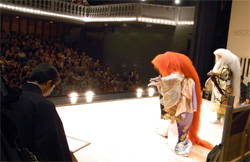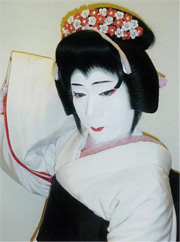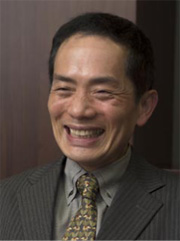Home > Highlighting JAPAN > Highlighting Japan JANUARY 2013 > Kabuki Abroad
Highlighting JAPAN
COVER STORY: WORLD HERITAGE—Windows on Japanese Culture
Kabuki Abroad
2012 marked the sixtieth anniversary of the establishment of diplomatic relations between Japan and Israel. To celebrate the anniversary, the Japan Foundation organized kabuki performances in Jerusalem and Tel Aviv. Osamu Sawaji of the Japan Journal spoke to Kyozo Nakamura, a kabuki actor who has been a prolific participant in lectures and workshops about kabuki outside Japan, including Israel.

Kyozo Nakamura (red hair) takes a curtain call at the Suzanne Dellal Centre for Dance and Theatre Tel Aviv, September 2012.
The art of kabuki is handed down through the families of kabuki actors. Kyozo is, however, one of a small number of kabuki actors who were not born into a family of kabuki actors. After graduating university, Kyozo studied at the Kabuki Actor Training Center of the National Theatre of Japan, and then became an apprentice with the leading onnagata actor Jakuemon Nakamura IV.

Kyozo Nakamura performs "Sagimusume," one of the kabuki dances.
"One of the things my Master taught me was the way onnagata use their bodies. My Master told me to move my insides and, at first, I was completely confounded, wondering what kind of movement he meant. After a long time, I eventually realized that he meant lithe body movements originating from the inside," says Kyozo. "Onnagata do not simply mimic women, they perform the roles of women while retaining the body and emotions of a man. The onnagata is a symbol of femininity as seen from a man's point of view."

Kyozo Nakamura
Credit: MASATOSHI SAKAMOTO
Overseas, it is rare to see kabuki performed in the same environment as Japan, which makes performances difficult. For example, the floor of a kabuki stage in Japan is laid with wooden boards and is flat, whereas overseas Kyozo often performs on a raked (angled) stage used to perform opera. In Central America, he once performed in hot, humid conditions without air conditioning, which left him dripping with sweat; in Denver in the United States and Mexico City in Mexico, which are located at high altitudes, he also struggled in the rarefied air.
"In Mexico City, I performed with an oxygen cylinder backstage and it was really hard. But when you hear the thunderous applause from the audience you forget how hard it is," says Kyozo. "Coming up with ways to create a kabuki space on a stage that is not usually used for kabuki is also fun."
When performing overseas, Kyozo runs kabuki workshops to try to promote a better understanding of kabuki. People are particularly interested in onnagata. Kyozo teaches the elegant gestures of onnagata through the acting of smiling and crying, performing these gestures along with the audiences.
"I think kabuki has become a universal language thanks to the great efforts of my predecessors," says Kyozo. "I would like to perform kabuki in the countries and cities I have not toured yet, to convey the wonder of kabuki to as many people as possible."
Kyozo appears in the evening performance (starting at 4.00 p.m.) of Kotobuki Hatsuharu Grand Kabuki at the Shimbashi Enbujo Theatre in Tokyo, until January 26.
The main theatre of Kabuki is the Kabuki-za Theatre, located in Tokyo's Ginza district. The Kabuki-za Theatre is currently undergoing reconstruction and will reopen on April 2.
|
Kabuki as Intangible Cultural Heritage of Humanity The Convention for the Safeguarding of the Intangible Cultural Heritage was adopted by the General Conference of UNESCO in 2003. As of December 2012, 148 countries are parties to the convention. The Convention defines "intangible cultural heritage" as "the practices, representations, expressions, knowledge, skills—as well as the instruments, objects, artifacts and cultural spaces associated therewith." Japan became a party to the convention in 2004, and twenty-one intangible cultural heritage elements from Japan are inscribed in the Representation List of the Intangible Cultural Heritage of Humanity. In 2008, Kabuki Theatre became one of the first intangible cultural heritage elements from Japan to be inscribed into the Representative List, along with Nogaku Theatre and Ningyo Johruri Bunraku Puppet Theatre. |
© 2009 Cabinet Office, Government of Japan






